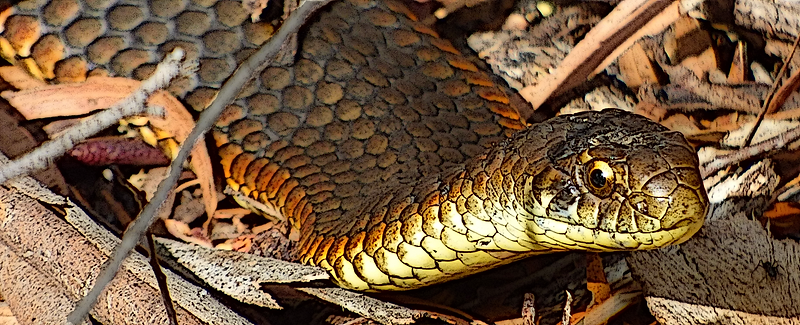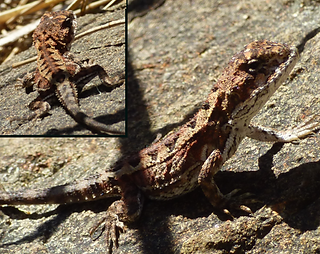
Reptiles
Snakes
= Seen by me on Knocklofty
= Photo taken at Knocklofty
LOWLAND COPPERHEAD
Austrelaps superbus

I spotted this snake on Knocklofty in February 2023. The lowland copperhead can be anything from reddish-orange on its back to black and has pale coloured eyes. It's not considered an aggressive snake but it does have a venomous bite which can be fatal. When feeling defensive, the snake raises its head and flattens its neck. If cornered, it will hiss loudly, flatten its body and thrash or flick about, but generally will only bite if provoked.
The lowland copperhead prefers colder environments and likes to live in areas of low vegetation near water bodies. It hunts for frogs, lizards and snakes, including smaller specimens of its own species.
Males fight each other at the beginning of the breeding season. Females give birth to live young (not eggs).
TIGER SNAKE
Notechis scutatus

Tiger snakes can grow up to 2m long. They vary in colour and may or may not have bands or mottles. I once spotted a juvenile on Knocklofty about the size of a pencil with bold yellow and black bands but generally in Tasmania they tend to be dark with only subtle patterns. The dark colour helps them absorb heat faster during the short growing season. Unlike the copperhead, their head is wider than their neck, and they have quite deep set eyes
Tiger snakes are highly venomous and can be aggressive when cornered. An untreated tiger snake bite can be fatal in 50% of cases.
Tiger snakes can live over 1000m above sea level in Tasmania. They can climb trees and buildings, and have been found 10m above the ground. They can also swim and may stay underwater for at least 9 minutes.
They give birth to 10-60 young or more. Young are born in a membranous sac. Once out of the sac they are totally independent.
WHITE LIPPED SNAKE
Drysdalia coronoides

Photo Wikipedia
Australia's most cold-tolerant snake, the white-lipped snake is small, growing up to 25-40cm in length. White-lipped snakes can be pale olive, grey, reddish brown or dark brown/black. They are easily identified by the white strip along the upper lip and neck. I've only seen two white-lipped snakes on Knocklofty - a juvenile with an orange underside and a gun metal grey snake that skimmed fluidly and gracefully across the path in front of me.
White-lipped snakes are venomous but are shy and have small fangs so bites are rare. I've seen them go into a state of frenzied wriggling on the spot when disturbed. They feed on small skinks and occasionally small frogs. They can forage in winter on fine days since their small size allows them to heat up quickly.
They may only breed once every two years in the wild. They give birth to 2-8 young a around March or April. When born. the young have a body length of 8-11 cm.
Skinks
BLOTCHED BLUE-TONGUE LIZARD
Tiliqua nigrolutea
WHITE'S SKINK
Liopholis whitii
OCELLATED SKINK
Carinascincus ocellatus



By far the largest of Tasmania's skinks, the blotched blue tongue is stouter and has shorter legs than most skinks, and rarely loses its tail. It can grow up to 30cm and weigh over 1kg, although most are less than half this. Blotched blue tongues eat both plants and animals (generally slower moving animals such as snails and beetles as they are not very agile themselves). Their teeth are large and they have strong jaw muscles so they can crush snail shells and beetles.
They have a fleshy blue tongue that is used to taste the air and scare off potential predators. They may also hiss and/or flatten out the body when feeling defensive. They may bite when picked up but are not venomous.
According to Australian Museum, several captive animals have lived for 20 years, and they may live much longer. They can live comfortably in suburban gardens, eating snails and small rodents.
This is a large, boldly patterned skink which grows up to around 25cm. They have variable patterning but the ones I've seen have a brown stripe on the back with two black stripes either side with pale spots.
These skinks dig and live in burrows, often reusing complex tunnels. They live in small family groups with up to five females per male. Wikipedia says they are a highly aggressive species that will viciously attack other individuals that they do not recognize or 'like' via scent. This includes outside females that the group could potentially include, making them very difficult to pair. Adults also will sometimes cannibalize rival juveniles they do not recognize.
Wikipedia also says that offspring are highly aggressive from the start and will fight amongst themselves to chase away other youngsters from the group. Once the youngster reaches is half grown, the adult will chase it out of the group by attacking it on sight. However, there is no citation for these comments,
Also known as the spotted skink, the ocellated skink is found only in Tasmania. It's quite abundant on Knocklofty - I see this skink more than any other species.
Ocellated means 'having eye-like markings'. This skink grows up to 8.5cm and can be copper-brown in colour, grey or dark brown. This is an attractive skink and the copper-brown variation is particularly handsome. Like White's skink, the ocellated skink likes basking on rocks and may quickly dart into hiding if it feels threatened. However, I have found it the least shy of the skinks I see in Knocklofty (except the blue tongue which doesn't seem to be able to dart or scuttle anywhere).
The ocellated skink, like all endemic Tasmanian species, gives birth to young skinks (i.e. not eggs).
METALLIC COOL-SKINK
Carinascincus metallicus

The helpful and knowledgeable experts at Australian Museum have confirmed that this skink is a metallic cool-skink.
This small skink is carnivorous and is found mostly in Southern Victoria and Tasmania, where it's the most common skink. Our garden is full of them. This us a live bearing species, and can produce up to eight young depending on the size of the female. Females store sperm in oviducts over winter after mating in autumn. Fertilisation occurs in spring and young are born the following summer.
SOUTHERN GRASS SKINK
Pseudemoia entrecasteauxii

This has been identified by the Herpetology team at Australian Museum and their research associates as a Southern Grass Skink. These skinks are very variable in colouring and pattern, so are difficult to differentiate from some other skinks. So it's nice to be able to call on the experts.
This species is very cold-tolerant. It grows to around 12 cm, often has a dark stripe along its back and its lower eyelid has a large clear window, allowing the eye to be seen when the eyelids are closed. Females give birth to around 2-5 live young. They eat insects but, according to Wikipedia, when food is short, females may cannibalize their young.
SOME KIND OF PSEUDEMOIA...
Pseudemoia spp

Australian Museum has identified this skink as a member of the Pseudemoia genus
but can't say what species it is. All I can say about this one is that it was quite small and much greener than the other skinks and I saw it in summer 2023.
EASTERN THREE LINED SKINK
Acritoscincus duperreyi

This is the one skink I am not sure about. It may be a Southern Grass Skink. But if it is an Eastern Three Lined Skink, its a small but very interesting little reptile. It grows up to around 8cm and has a bold dark strip down either side with a thinner pale line above and below it. Hatchlings have bright red throats, which fades to an orange-pink or disappears after a few weeks of life.
When facing a predator they may wiggle their tails in a vertical position, possibly to focus the predator on the tail which can be jettisoned while the lizard escapes. Hatchlings have shown that they can learn to navigate mazes and undertake visual discrimination tasks based on colour.
These skinks are egg-laying, and up to three females may lay their eggs in one nest. The temperature at which the egg incubates seems to have significant effects on the learning, behaviour and development of these skinks. Cooler temperatures may cause skinks with female chromosomes to show male characteristics.
Hatchlings incubated in warmer conditions appear to have much stronger learning abilities.
Dragon
MOUNTAIN DRAGON
Rankinia diemensis

My favourite of all the Tasmanian reptiles, this small reptile has a great sense of personal style. At only 9cm or thereabouts, it has spines along its back, a large head, striking markings of light and dark triangles, and a world-weary look in its eye. If you are slow and quiet, I have found you can get quite close to it. The above photo was taken next to the steps leading up from the Mt Stuart lookout. I have seen mountain dragons alongside these steps three times (as at January 2024) and nowhere else on Knocklofty. The one above was very tolerant of my close proximity, basically sitting next to it on the step, and my camera.
Mountain dragons are largely ground-dwelling and rely on their excellent camouflage and a quick scuttle into vegetation for defense against predators.
The female is larger than the male, and she lays up to 9 eggs in a burrow. Mountain dragons eat insects.
Sources
Animal Diversity Web. Tiliqua nigrolutea - Blotched Bluetongue, Southern Bluetongue, Blotched Blue-Tongued Lizard.
https://animaldiversity.org/accounts/Tiliqua_nigrolutea/
Animalia. Lowland copperhead. https://animalia.bio/lowland-copperhead
Atlas of Living Australia. Carinascincuc metallicus: Metallic cool-skink. https://bie.ala.org.au/species/https:/biodiversity.org.au/afd/taxa/c91fb6cc-4476-4daa-8437-c56a9eff9397
Atlas of Living Australia. Pseudemoia entrecasteauxii : Southern Grass Skink.
https://bie.ala.org.au/species/https:/biodiversity.org.au/afd/taxa/1533ed80-cb92-45e0-bda1-1801f995fcf7
Atlas of Living Australia. Rankinia diemensis: Mountain Dragon. https://bie.ala.org.au/species/https:/biodiversity.org.au/afd/taxa/73375100-0957-49a5-94e8-ec0599a60dd0
Australian Museum. Blotched Blue-tongue Lizard. https://australian.museum/learn/animals/reptiles/blotched-blue-tongue-lizard/
Australian Museum. Tiger Snake. https://australian.museum/learn/animals/reptiles/tiger-snake/
Department of Natural Resources and Environment Tasmania. Spotted skink. https://nre.tas.gov.au/wildlife-management/fauna-of-tasmania/reptiles-and-frogs/tasmanian-lizards/spotted-skink
Department of Natural Resources and Environment Tasmania. White-lipped snake. https://nre.tas.gov.au/wildlife-management/fauna-of-tasmania/reptiles-and-frogs/tasmanian-snakes/white-lipped-snake
iNaturalist. Eastern Three-lined Skink Acritoscincus duperreyi. https://www.inaturalist.org/taxa/966815-Acritoscincus-duperreyi
Jungle Dragon. Blotched blue-tongued lizard - Tiliqua nigrolutea. https://www.jungledragon.com/specie/826/blotched_blue-tongued_lizard.html
McNab, A (2018). The Guide to Tasmanian Wildlife. Forty South Publishing.
Museums Victoria Collections. Acritoscincus duperreyi (Gray, 1838), Eastern Three-lined Skink.
https://collections.museumsvictoria.com.au/species/15610
Museums Victoria Collections. Rankinia diemensis (Gray, 1841), Mountain Dragon. https://collections.museumsvictoria.com.au/species/8376
Wikipedia. Pseudemoia entrecasteauxii. https://en.wikipedia.org/wiki/Pseudemoia_entrecasteauxii
Wikipedia. White-lipped snake. https://en.wikipedia.org/wiki/White-lipped_snake
Wikipedia. White’s Skink. https://en.wikipedia.org/wiki/White%27s_skink